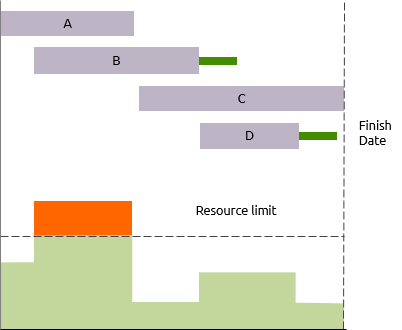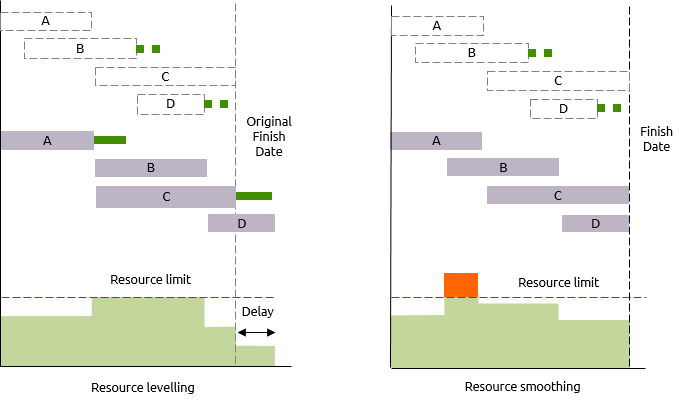Resource limited scheduling is based on critical path analysis but schedules activities according to the availability of resources.
The diagram below shows a Gantt chart and resource histogram. The resource limit indicates the number of resources available and the finish date of the ‘project’ is calculated by critical path analysis. The red area indicates the period during which demand exceeds supply.

Resource limited scheduling comprises two approaches: resource levelling and resource smoothing.
Resource levelling schedules activities so that there are no resource overloads. This almost invariably results in a later finish date for the project.
Resource smoothing assumes that the finish date calculated by critical path analysis cannot be delayed. This means that no activity can be delayed by more than its total float. The resource histogram is ‘smoothed out’ as much as possible but some overloads remain.
In the diagrams below, the unshaded bars indicate the results of critical path analysis and the shaded bars indicate the timing of activities after resource limited scheduling.
In the first diagram, Activity B has been delayed so that it no longer conflicts with A. Activity D has also been delayed and this has resulted in a delay to the finish date.
In the second diagram, Activity B has been delayed in order to take up some of the spare capacity. Because it has not been delayed beyond its available float it has not affected the finish date although it has resulted in Activity D being delayed. There is still some overload, but less than before.

This example only uses one scheduling option i.e. to delay activities. There are many other options and these are supported to a greater or lesser degree by different scheduling software.
The options for manipulating activities are:
- Delay an activity within its float to a period when resources are available (the only allowable delay in resource smoothing).
- Stretch an activity to use resources at a lower rate.
- Compress an activity to use resources at a higher rate.
- Alter the profile of resource usage across the duration of the activity.
- Delay an activity beyond its float and extend the project (this is only allowable in resource levelling).
- Split an activity so that the resulting smaller activities can make use of pockets of resource availability.
- Alter the logic of the network to allow activities to start earlier.
Options for manipulating resources are:
- Recruit more resource
- Provide training to develop multiple skills
- Employ alternative (less labour intensive) working methods
- Work overtime
In practice the best solution is likely to be a combination of a number of actions. Maybe it would be acceptable to delay completion a couple of days, have two people work a couple of Saturdays, compress an activity by two or three days and so on.
Care must be taken when using computer software for resource limited scheduling. Sophisticated algorithms will make many changes to a project schedule that are not always easy to follow, especially when multiple resources are being scheduled simultaneously.
It is often beneficial to use resource limited scheduling as a ‘what if’ approach coupled with sensitivity analysis, rather than a means of producing a definitive project schedule (see article 'Sensitivity analysis in resource scheduling')





